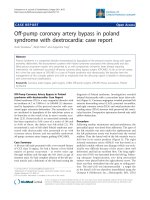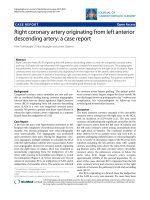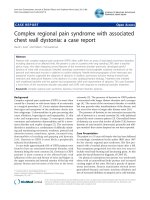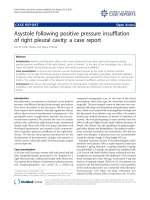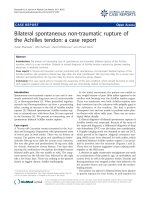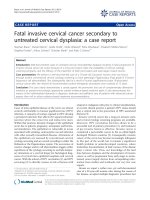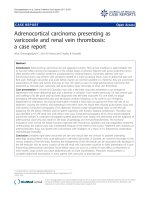Báo cáo y học: " Visor flap for total upper and lower lip reconstruction: a case report" pdf
Bạn đang xem bản rút gọn của tài liệu. Xem và tải ngay bản đầy đủ của tài liệu tại đây (2.96 MB, 5 trang )
Case report
Open Access
Visor flap for total upper and lower lip reconstruction: a case report
Peter Nthumba* and Louis Carter
Address: Department of Surgery, AIC Kijabe Hospital, Kijabe 00220, Kenya, Africa
Email: PN* - ; LC -
* Corresponding author
Received: 20 May 2008 Accepted: 22 January 2009 Published: 9 June 2009
Journal of Medical Case Reports 2009, 3:7312 doi: 10.4076/1752-1947-3-7312
This article is available from: />© 2009 Nthumba and Carter; licensee Cases Network Ltd.
This is an Open Access article distributed under the terms of the Creative Commons Attribution License (
/>which permits unrestricted use, distribution, and reproduction in any medium, provided the original work is properly cited.
Abstract
Introduction: Noma, aptly named the ‘face of poverty’, is a scourge with a mortality rate of up to
90% that affects some 140,000 people each year, predominantly children in the sub-Saharan ‘noma
belt’. Survivors of the acute attack suffer severe facial disfigurement from loss of facial tissue and
scarring. Surgical reconstruction of noma defects is a major challenge, especially in Africa, where the
majority of cases occur.
Case presentation: We report the case of a 40-year-old Somali man who presented with severe
facial disfigurement, including total absence of both upper and lower lips. After a failed initial
reconstruction, a combination of platysma flaps and a left deltopectoral flap provided mucosal lining,
while a scalp visor flap served to recreate upper and lower lips, the beard and moustache.
Conclusion: The scalp visor flap offers a simple but extremely versatile tool for use in midfacial
reconstruction, especially in the male, providing neo-lip tissue, a moustache and a beard. This is the
first report of a simultaneous total upper and lower lip reconstruction using a scalp visor flap, in the
English literature. We also emphasize on a process of transfer of skills to enable local surgeons to
effectively manage the challenge that noma presents.
Introduction
Noma, also known as cancrum oris, primarily affects
orofacial structures. There is a strong correlation between
noma and poverty, malnutrition, poor oral hygiene and
infectious diseases [1] - conditions that are widespread in
sub-Saharan Africa, particularly within strife-ridden com-
munities. This scourge has been aptly called the ‘face of
poverty’ [2], and afflicts mainly children in the developing
world, with only a few cases reported from the developed
world - these involve patients with debilitating diseases
such as HIV/AIDS, diabetes mellitus and hematological
disorders [3-4]. Noma was eradicated in developed
countries because of improved standards of living, a better
understanding of the disease and the use of antibiotics,
while in other places, a significant fall in mortality was
reported (from about 90% to 10%) [5]. Unfortunately,
about 140,000 new cases of noma still occur each year in
the sub-Saharan “noma belt”. Ninety percent of these
children die without any treatment [6].
Survivors of the acute stage suffer severe destruction of the
midface, including lips, cheeks, maxilla and mandible,
nose and occasionally, the orbit [5]. Progressive scarring,
trismus, oral incontinence and mandibulo-maxillary
Page 1 of 5
(page number not for citation purposes)
synostosis leave the patient malnourished, severely dis-
figured and with speech difficulties.
Although cases of noma have been reported from East
Africa (Kenya, Uganda and Tanzania) [7], it remains
somewhat uncommon in this region. Political upheaval in
surrounding countries over the years have created large
populations of refugees, who have brought with them
health problems hitherto unfamiliar to many physicians
in the region; chief amongst them is noma, with its
numerous management challenges.
This case report describes the authors’ experience with the
first noma patient managed at our hospital, and the
valuable lessons learnt. This is also the first report of a total
upper and lower lip, beard and moustache reconstruction
using a scalp visor flap in the English literature.
Case presentation
A 40-year-old Somali man presented to our hospital with
a large midfacial defect, inability to open his mouth, oral
incompetence and incoherent speech. Eight years prior to
his presentation, he had noted a small blister in his left
maxillary buccal mucosa, which had ruptured and a few
weeks later had left a small ulcer that pro gressively
increased in size with time. He eventually lost both his
upper and lower lips, parts of the maxilla and some teeth,
as well as the ability to open his mouth. Concurrently, he
had developed difficulties with eating and speech.
On examination, he had a hideously deformed face - an
extensive ulcer covered what used to be his mouth and
midface. A deep ulcer cavity with a foul-smelling purulent
discharge covered what used to be his left maxilla. Most of
what remained of his left upper and lower dentition was
visible through the soft tissue defect. On the right side,
the esion was less extensive but also had no lip tissue
(Figure 1). An orthopantogram revealed bilateral chronic
osteom yelitis of his midfacial skeleton with bilateral
maxilla-mandibular ankylosis. He did not have diabetes
mellitus, HIV/AIDS, or any other co-morbidity.
A feeding gastrostomy and a tracheostomy preceded the
midfacial reconstruction, which initially involved bilateral
excision of the bony block between the mandible and
maxillae, mobilization of the temporomandibular joint
and soft tissue coverage achieved by use of bilateral
pectoralis major muscle myocutaneous flaps.
Unfortunately, poor communication, misunderstanding
and significant differences in surgeon and patient expecta-
tion led to the patient destroying this initial reconstruction
on the first 3 postoperative days. He had expected to look
his “normal old self” immediately postoperatively, and
such was his disappointment with the results, that he
stoically tore through his flaps, destroying the entire
reconstruction.
After discussion with the patient and his relatives, a staged
reconstruction was agreed upon. Bilateral platysma flaps
and a left deltopectoral flap were used for intra-oral lining,
with the deltopectoral flap providing the lower lip lining,
along with additional bulk needed to fill the defect over
the left maxilla (Figures 2 and 4). A scalp visor flap was
designed and prefabricated with a skin graft, and subse-
quently raised a week later. This was used to cover the
mid faci al defect, reconstruct his lips, and provide a
moustache and beard, all as a single unit. The scalp defect
was skin grafted.
Although continence to solids was gained, he remained
incontinent to liquids. Non-adherence to postoperative
rehabilitation led to significant loss of mouth opening,
from 35 mm immediately postoperatively to about
10 mm at 2 years.
Discussion
Reconstruction in noma surgery is a surgical adventure
not to be taken lightly; for this reason many workers
have preferred transferring these patients to hospitals in
Figure 1. Picture showing extent of defect, with complete
absence of lip tissue, as well as inability to open mouth.
Page 2 of 5
(page number not for citation purposes)
Journal of Medical Case Reports 2009, 3:7312 />the developed world, where supporting technology and
skills make the surgeries much easier and safer to
perform [ 8]. This strategy, although successfully running
for many years, is a very expensive undertaking, when
compared to the alternative where the patient is
managed locally. Managing these patients locally offers
multiple advantages including treatment within their
own locale, a lower cost per surgery and therefore larger
volumes of patients, and more importantly permits the
transfer of skills and technology over time, through the
training of local surgeons [9], as has also been our
experience [10]. Sustained quality management of
patients in the absence of the visiting specialist surgical
team, is proof of successful transfer of knowledge, skills
and technology. Continued partnership between the
visiting specialist and local surgical team further
enhances patient care by helping expand and maintain
skills lo cally, while sim ultaneously freeing up availabl e
fundingforthecareofmorepatientsaswellasthe
purchase and/or maintenance of necessary equipment, a
much cheaper, more effective a nd sustainable solution
to the challenges facing reconstructive surgery in Africa
and other developing environments.
In the presence of remaining lip tissue, the goals of lip
reconstruction include the restoration of oral competence,
maintenance of maximum oral aperture, mobility, sensa-
tion when possible, and cosmesis [10,11]. When there is
absolutely no lip tissue available however, surgery can
only attempt to reconstruct an alternative that will permit
the acceptance and re-entry of the patient back into
society. Form becomes paramount above function and
beauty. While either free flaps or loco-regional flaps may
be used in noma surgery, the type of reconstruction is
largely determined by the surgeon’s preference, skills,
funding and technology.
Free flaps offer the reconstructive surgeon considerable
versatility. Single stage reconstruction with appropriate
tissue bulk and the avoidance of additional facial scars/
incisions are important advantages. They are, however
labor- a nd techn ology-dependent, expensive, and
demand considerable technical skills. Free flaps are
relatively new entrants in lip reconstruction. While most
workers prefer the radial forearm flap use of the gracilis
Figure 2. The deltopectoral flap was raised, and fashioned to
form the inner lining. Chest defect at 6 weeks.
Figure 3. Mature scars over neck and chest. The platysma
donor sites healed completely, with inconspicuous scars.
Figure 4. Defect reconstructed, with ability to open mouth.
Note resulting scalp donor alopecia.
Page 3 of 5
(page number not for citation purposes)
Journal of Medical Case Reports 2009, 3:7312 />muscle and the anterolateral thigh flaps have also been
reported [11]. Microvascular reconstruction has been
successfully performed in sub-optimal environments,
proving that these skills and technology can be modified
to suit th e op erating theater con ditions found in
most developing countries [12]. This service will be a
significant improvement on the quality of car e locally
available to these patients.
Loco-regional flaps provide excellent color match, mini-
mize the number of surgical procedures, and are generally
fail-safe, requiring simple postoperative care.
The scalp visor flap has an excellent blood supply,
guaranteed by its double pedicle with the two superficial
temporal arteries. The scalp visor flap and its modifica-
tions have been used for the reconstruction of beards and
moustaches in males after facial burns. Its use thus far,
has been confined to resurfacing injured tissue. Only skin
and subcutaneous tissue was injured in these patients
[13,14].
Gousheh et al. used occipital scalp island flaps for total
upper lip reconstruction [15]. There is no previous report
of a simultaneous total upper and lower lip reconstruc-
tion, in a patient with a complete absence of lip tissue. The
scalp visor flap in this patient was used to reconstruct the
missing midfacial and lip tissue, as well as recreate a
moustache and beard. Thus while simple to design and
elevate, this flap served multiple functions, and gave
invaluable solutions to otherwise technicall y difficult
reconstructive needs in this patient. It gave an excellent
color match with the remaining facial skin, provided
aesthetic neo-lips, complete with a moustache and a
beard, as a single unit (Figure 5). The patient and relatives
found the reconstruction acceptable, but expressed a desire
for a procedure that would allow oral continence. While a
face transplant would give the best results in terms of
aesthetics and function, this was not achievable in this
patient and his environment at this time. An attempt at
restoring oral continence using free functional muscle
transfer will be made.
The major criticism against the classic visor flap is the
defect left in the donor area - a large area of alopecia
(Figure 4). This may be overcome by the use of a tissue
expander, or, as in the present case, by acceptance by the
patient, by virtue of existing cultural practice - the use of a
headscarf, which is only taken off at night, or when
bathing. Other donor defects, over the chest and neck,
were more aesthetically acceptable, as well as being easily
hidden by clothing (Figure 3).
Maintaining acceptable mouth opening and mandibular
function post-reconstruction remains a significant pro-
blem [8], as in this patient, where at 2 years, the mouth
opening remains at about 10 mm, down from an
immediate postoperative 35 mm. Postoperative phy-
siotherapy, with night splinting for up to a year, a highly
patient- and guardian-dependent variable, is the main
determinant of a good result.
Conclusion
Jointly setting achievable goals with the patient and their
relatives forms the foundation for successful noma
reconstruction, as we found out. Most patients want to
be able to eat sufficient amounts of food, be comfortable
with their faces, and be accepted by the community within
which they continue to live. While accommodating these
basic expectations, goal setting must be realistic, achiev-
able and acceptable to all the parties involved. The scalp
visor flap is a simple yet excellent reconstructive solution
for midfacial defects.
Consent
Written informed consent was obtained from the patient
for the publication of this paper and any accompanying
images. A copy of the consent is available for review by the
Editor-in-Chief of this journal.
Competing interests
There is no association between the authors with any
commercial firm, and no grants were given for this
article. There are no competing interests in the publication
of this article.
Authors’ contributions
This manuscript is original and has not been published
previously nor is under review by any other journal. PN
and LC are jointly responsible for the entire content of this
article.
Figure 5. Reconstruction showing neo-lips, moustache and
beard at 1 year.
Page 4 of 5
(page number not for citation purposes)
Journal of Medical Case Reports 2009, 3:7312 />References
1. Enweon WU: Epidemiological and biochemical studies of
necrotizing ulcerative gingivitis and noma (cancrum oris) in
Nigerian children. Arch Oral Biol 1972, 17:1357-1371.
2. Marck KW: A history of noma, the “face of poverty”. Plast
Reconstr Surg 2003, 111:1702-1707.
3. Bendl BJ, Padmos A, Harder EJ, McArthur PD: Noma: report of
three adult cases. Australas J Dermatol 1983, 24:115-121.
4. Chidzonga MM: HIV/AIDS orofacial lesions in 156 Zimbabwean
patients at referral oral and maxillofacial surgical clinics. Oral
Dis 2003, 9:317-322.
5. Tempest MN: Cancrum oris. Br J Surg 1966, 53:949-969.
6. Myburgh NG, Hobdell MH, Lalloo R: African countries propose a
regional oral health strategy: The Dakar Report from 1998.
Oral Dis 2004, 10:129-137.
7. Chindia ML, Guthua SW, Kimaro SS, Mos hy J: Gangrenous
stomatitis (cancrum oris): clinical features, etiologic factors,
and complications. Quintessence Int 1997, 28:277-278.
8. Montandon D, Lehmann C, Chami N: The surgical treatment of
noma. Plast Reconstr Surg 1991, 87:76-86.
9. Marck KW, de Bruijn HP, Schmid F, Meixner J, van Wijhe M, van
Poppelen RHM, Noma: The Sokoto approach. Eur J Plast Surg
1998, 21:277-281.
10. Nthumba PM: The donkey, the fox, the gun and a lip. The Internet
Journal of Surgery 2005, 6. [ />xmlFilePath=journals/ijs/vol6n2/lip.xml] Accessed 26
th
March 2008.
11. Nabili V, Knott PD: Advanced Lip Reconstruction: functional
and aesthetic considerations. Facial Plast Surg 2008, 24:92-104.
12. Giessler GA, Schmidt AB. Noma: Experiences with a micro-
vascular appro ach under West African conditions. Plast
Reconstr Surg 2003, 112:947-954.
13. Hassanpour SE, Shariati SM: Simultaneous reconstruction of
upper and lower lip beside chin and nasal lobule: In a case of
facial chemical burn. Burns 2007, 33:522-525.
14. Hafezi F, Naghibzadeh B, Nouhi A: Facial reconstruction using the
visor scalp flap. Burns 2002, 28:679-683.
15. Gousheh J, Arab H, Motam ed S: Superior cheiloplasty by
occipital scalp island flap in male patients. Plast Reconstr Surg
2003, 111:1221-1226.
Page 5 of 5
(page number not for citation purposes)
Journal of Medical Case Reports 2009, 3:7312 />Do you have a case to share?
Submit your case report today
• Rapid peer review
• Fast publication
• PubMed indexing
• Inclusion in Cases Database
Any patient, any case, can teach us
something
www.casesnetwork.com

